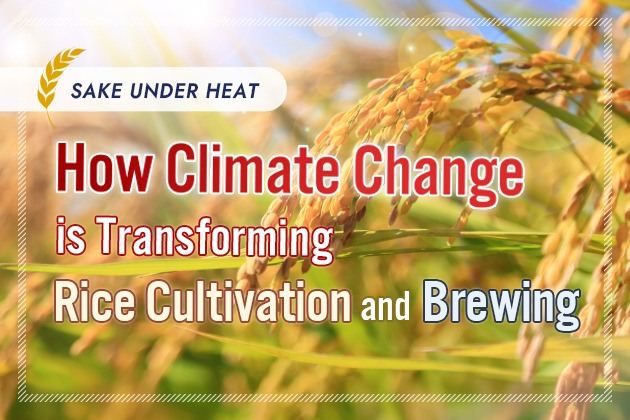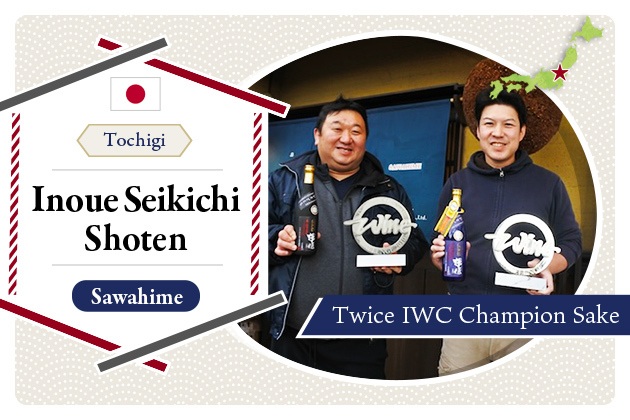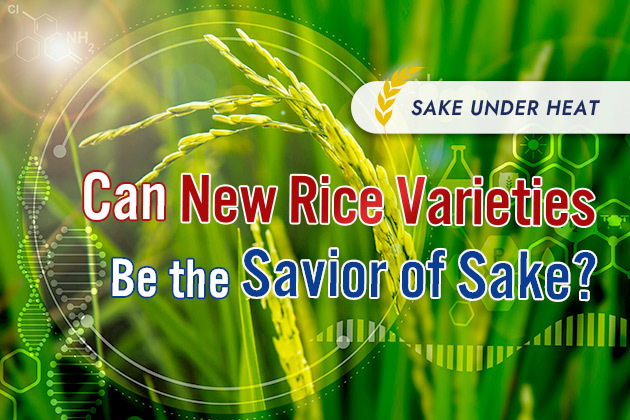
2025.10
22
Sake Under Heat: How Climate Change Is Transforming Rice Cultivation and Brewing (1-2)
According to the Japan Meteorological Agency, the nation’s average temperature in 2024 reached an all-time high, with unprecedented heatwaves observed across the archipelago. In recent years, such extreme temperatures have been exerting wide-ranging effects on the natural environment—and on agriculture in particular.
Rice, the essential ingredient for sake, has been no exception. Increasing reports of so-called “heat damage”—growth disorders caused by elevated temperatures—have sparked concern among both farmers and brewers. In fact, climate change was one of the factors behind the decision of Michizakura Shuzo, once based in Gifu Prefecture, to relocate its brewery to Hokkaido.
How, then, is climate change shaping the future of sake production? And what strategies can be adopted to meet these challenges? In this series, Sake Under Heat, we draw on data and interviews with farmers and brewers to explore how a warming climate is transforming sake rice—and the sake industry itself.
Climate Change Today and Its Impact on Rice
Before we look at how climate change is affecting sake rice and brewing, it’s important to first understand the current state of Japan’s climate and the damage already being observed in rice cultivation.
The Current State of Warming in Japan
Japan’s average temperature has fluctuated from year to year, but over the long term it has been rising at a rate of 1.40°C per century. That is about 1.8 times faster than the global average of 0.77°C per century. One reason for this accelerated pace is Japan’s geographical location: in the mid-latitudes of the Northern Hemisphere, where the effects of climate change are particularly pronounced.
Of the seven hottest years on record since observations began in 1898, all have occurred within the past decade—clear evidence that global warming is intensifying in recent years. The frequent reports of sudden downpours and severe flooding in Japan are also tied to climate change, as long-term increases in atmospheric water vapor have led to heavier rainfall events.
Japan’s annual average temperature anomaly (Source: Japan Meteorological Agency)
| Rank | Year | Difference from 1991–2020 average |
|---|---|---|
| 1 | 2024 | +1.48 |
| 2 | 2023 | +1.29 |
| 3 | 2020 | +0.65 |
| 4 | 2019 | +0.62 |
| 5 | 2021 | +0.61 |
| 6 | 2022 | +0.60 |
| 7 | 2016 | +0.58 |
| 8 | 1990 | +0.48 |
| 9 | 2004 | +0.46 |
| 10 | 1998年 | +0.45 |
A Sharp Decline in Top-Grade Rice: What is Heat Damage?
Rising temperatures are causing heat-related damage to rice, including table rice. According to the Ministry of Agriculture, Forestry and Fisheries’ 2023 Climate Change Impact Survey Report, published in 2024, the unusually high summer temperatures in 2023 led to widespread occurrence of chalky immature grains caused by heat stress. The report notes that such damage affected about 50% of rice nationwide. Because Japan stretches across such a wide north–south axis, however, the extent of the impact varied by region: roughly 50% in northern and eastern Japan, compared to about 40% in western Japan.
Before being sold, rice is inspected in its brown rice form and graded based on factors such as the proportion of well-shaped grains, moisture content, and the percentage of damaged or discolored grains. The highest quality is certified as “Grade 1 rice.” Yet in 2023, the incidence of damaged grains rose significantly due to heat stress, leading to a sharp drop in the share of rice meeting this top grade.
Heat damage to rice can take several forms. Beyond the defects that affect grading, it can also influence eating quality—for example, cooked rice may finish more quickly and turn out watery.
| Type of Grain Damage | Description | Cause |
|---|---|---|
| Chalky white grain | Starch does not fully develop, leaving gaps that scatter light and give the grain a cloudy white appearance. | High temperatures and insufficient sunlight during the ripening stage. |
| White-back grain | Poor starch accumulation along the back (the side without the germ), causing a cloudy white appearance. | More strongly linked to high temperatures than chalky white grains. Believed to occur when the grain’s ability to receive assimilates declines prematurely due to heat. Can also result from nitrogen deficiency during ripening. |
| Fissured grain | Cracks form in the endosperm due to uneven absorption and drying of moisture. | Cycles of wetting and drying before harvest (e.g., heavy rain), delayed harvesting, or excessive drying after harvest. Extended periods of high temperature (about 10 days) after heading also make this more likely. |
| Black-spotted grain | The surface of the brown rice cracks and develops dark streaks, categorized as discolored grains. | High temperatures and water stress. |
How Does Heat-Damaged Rice Affect Sake Brewing?
What impact does heat stress in rice have on sake production? To explore this question, we spoke with two breweries that combine expertise in both rice and brewing: Niizawa Sake Brewery (Miyagi), whose president and staff hold rice grading licenses and manage their own polishing, and Kenbishi Shuzo (Hyogo).
1. Cracking During Polishing and Washing
Ritsu Asano, president of Rice Corporation—a rice-polishing company affiliated with Niizawa Sake Brewery—says the signs of heat damage are immediately evident when opening bags of rice delivered from farmers.
“You can see the difference just by opening the bag. Years ago, the grains had a glossy sheen, but in the past five years, I’ve noticed they look whiter, less lustrous,” Asano explains.
It’s not just appearance. The grains have become more brittle and prone to breaking, which requires extra care and slows down the polishing process.
“We run the polishing machines slowly and carefully, making fine adjustments to minimize breakage. Still, some irregularly shaped grains or broken pieces inevitably appear. That’s why we ask brewers to adjust their washing methods to suit the condition of the rice,” Asano says.
According to Masataka Shirakashi, president of Kenbishi Shuzo, the problem can also appear not during polishing, but at the washing stage.
“Unlike fissured kernels, these grains split vertically down the middle. It’s likely that excessive summer heat is causing the shinpaku—the opaque starchy core—to grow too large,” Shirakashi notes.
2. Reduced Solubility
In recent years, brewers have increasingly reported—often through social media—that “the rice doesn’t dissolve.” When sake is brewed with heat-damaged rice, the grains often fail to break down sufficiently in the moromi.
In brewing, the phrase “rice dissolves” refers to the process in which enzymes convert rice starch into sugar. To facilitate this, rice is steamed so that the starch is gelatinized (α-conversion), making it more susceptible to enzymatic action. However, gelatinized starch gradually undergoes retrogradation (re-crystallization), which reduces its digestibility by enzymes.
Starch is composed of two components: amylose and amylopectin. Rice exposed to high temperatures during the ripening stage develops a higher proportion of short side chains in the amylopectin molecules.
When amylopectin contains more of these side chains, retrogradation occurs more quickly. As a result, rice exposed to high heat is believed to become less digestible in the moromi, slowing down fermentation and reducing overall solubility.
3. Rising Costs
If rice does not dissolve properly during fermentation, the resulting sake lacks depth of flavor. Iwao Niizawa, president of Niizawa Sake Brewery, explains:
“When we say the rice doesn’t dissolve, it can mean the sake turns out clean and crisp. But at the same time, it also means production costs go up.”
For example, depending on how well the rice breaks down, the kasu-buai—the proportion of sake lees relative to the weight of the raw rice—can vary widely, from 30% to as high as 60%. This can lead to a production volume difference of nearly 30%, which is no small matter.
Niizawa continues:
“Every brewery has its own target flavor, so whether the sake becomes lighter or fuller-bodied can’t simply be judged as good or bad. But what matters is whether we can deliver the same quality that people expect from a given brand. We can push the rice to dissolve by choosing different koji strains or altering brewing methods, but that often results in a coarser flavor. With rising costs of production, the delicate balance between price and flavor can become critical—and sometimes fatal—for a product.”
Can Heat Damage Be Managed?
Heat damage to rice has already begun to affect sake production. Given the scale of the problem and the ongoing rise in temperatures, there is growing concern that conditions may remain unchanged—or even worsen—in the years ahead. What countermeasures are available to brewers and farmers?
1. Brewing Adjustments: Using Predictive Data to Guide Methods
In response to the growing impact of heat-damaged rice, the National Research Institute of Brewing (NRIB) now publishes an annual Sake Rice Suitability Forecast, which predicts how easily sake rice will dissolve each year.
As research has shown, rice solubility is closely tied to the temperature during the grain-filling stage. By analyzing climate data, the NRIB forecast estimates regional variations in rice solubility for a given year. Instead of relying solely on trial and error during fermentation, brewers can use these predictions to adjust their brewing processes in advance, enabling more precise production management.
Practical measures available during brewing include:
- Increasing the water absorption ratio of kakemai (steamed rice)
- Producing koji with higher enzymatic power
- Selecting seed koji strains that generate stronger enzyme activity
- Reducing the water-to-rice ratio in the moromi mash
- Adding commercial enzyme preparations to promote fermentation
In addition, new data suggests that flattened polishing (henpei seimai) can improve solubility compared to conventional spherical polishing. A joint study by Satake (a Hiroshima-based rice milling machine manufacturer) and the Hiroshima Prefectural Technology Research Institute Food Technology Center found that, when comparing the same rice polished into spherical versus flattened grains, the flattened polishing yielded steamed rice with higher Brix values—an indicator of digestibility and ease of dissolution.
2. Farming Practices: Night Irrigation and Adjusting Planting Schedules
Because Rice Corporation handles polishing not only for Niizawa Sake Brewery but also for many other breweries, rice from a wide range of regions and producers arrives at their mill. According to Asano, the degree of heat damage varies considerably by origin. She explains one practice used to mitigate the problem: night irrigation.
“When paddies are kept flooded, high daytime temperatures can heat the water. To prevent this, farmers sometimes drain the water at night, then refill the paddies with cooler water once the temperature has dropped.** This keeps the roots from being constantly submerged in hot water and helps maintain a certain level of quality,**” Asano explains.
However, this method is only feasible in areas with abundant water resources.
“If multiple breweries share the same irrigation channels, conflicts can arise among farmers over who gets to draw water at a given time. Unless the channels themselves are well maintained, there can also be problems with distributing water evenly to each field,” she adds.
Shirakashi, president of Kenbishi Shuzo, points to another possible countermeasure: delaying the timing of rice planting, which in recent decades has been pushed earlier by modernization.
“Traditionally, Japan practiced double cropping, planting rice only after the wheat harvest. But as fewer people work full-time in farming, rice planting has been happening earlier and earlier. For example, the ideal harvest time for Yamadanishiki is around October 10. Since typhoons often hit then, many farmers prefer to harvest in late September or early October instead.
As a result, planting begins earlier, and the grain-filling stage ends up overlapping with the hottest period of summer. In recent years, typhoons themselves have been coming earlier too. Delaying planting could actually reduce damage overall—including heat stress,” Shirakashi notes.
Other approaches under study include managing water levels during the latter half of the grain-filling stage and supplementing nutrients such as silica.
Challenges in Climate Adaptation for Rice Cultivation
In response to climate change, Yamadanishiki—once primarily grown in western Japan—is now increasingly being cultivated in cooler regions such as Tohoku and Hokkaido. Yet relocating production is not without challenges.
“Each rice variety has been bred to suit the climate and environment of its native region. Moving it elsewhere doesn’t automatically mean it will thrive,” explains Asano.
Shirakashi of Kenbishi Shuzo also points to other limitations:
“While temperatures are rising due to global warming, sunshine hours are not. Northern Japan has shorter daylight periods, so varieties that can ripen with limited sunlight are needed there. In addition, Yamadanishiki grown in Hyogo Prefecture must meet a grain-size standard of 2.05 mm, but other prefectures sometimes use smaller benchmarks. That difference can affect quality.”
Yamadanishiki remains widely used because it is relatively easy to handle and has been extensively studied. But Shirakashi warns that overreliance on a single variety could narrow the diversity of sake flavor:
“Compared with wine, sake is often said to show less sense of terroir. Developing varieties suited to each region may ultimately be a more efficient path to producing high-quality sake.”
Meanwhile, research is underway to develop heat-tolerant rice varieties that retain quality under high temperatures. Among table rice, Yamagata’s Tsuyahime and Nagasaki’s Nikomaru were bred with this purpose in mind. But Niizawa is cautious about their use in sake brewing:
“For table rice, demand for heat-tolerant varieties is high. But in sake brewing, other technical adjustments are possible, so I doubt many breweries would switch to such varieties just for that reason.”
“Sake quality isn’t determined by rice alone. It’s the combination of techniques that shapes the final product. Many sake brands are also tied to specific rice varieties, so adapting brewing methods is usually a faster solution,” Niizawa adds.
Even when new varieties are developed, adoption is slow. Since most breeding programs are conducted at the prefectural level, mismatches often arise between production costs, demand, and brewery uptake.
Looking further ahead, Shirakashi emphasizes the need for long-term strategies that take both past and future risks into account:
“Rice is originally a crop from warm regions, so breeding has traditionally aimed at adapting it to cold climates. But if varieties become too late-ripening, they risk total crop failure in years of cold damage. In fact, the 1990s and 2000s saw severe cold weather that drastically reduced yields. Heat damage is a real problem, but equally important is how we shift direction to adapt to climate change in its broader sense.”
Summary
In recent years, heat damage has become a growing challenge for both farmers and brewers. While there is still room for ingenuity, the causes and countermeasures vary depending on climate, location, and other conditions—making it essential to adopt site-specific approaches.
Equally important is collaboration not only among farmers, but also across cooperatives, rice-polishing companies, and breweries to implement the most effective strategies. In the second part of this feature, we will explore how such collaboration can be built—between farmers and brewers, and across regions.
References
- National Institute for Environmental Studies, Japan: Climate Change Adaptation Platform (A-PLAT)
- Japan Meteorological Agency website: Annual Average Temperature Anomalies in Japan
- Ministry of Agriculture, Forestry and Fisheries: FY2023 Report on the Impacts of Global Warming
- Masaki Okuda: Exploring the Mysteries of Sake Rice (National Research Institute of Brewing)
- Mie Prefectural Industrial Research Institute / Mie Prefectural Climate Change Adaptation Center: How Heat Affects Sake Brewing
- JA Minori Agricultural Cooperative, Soil Management Workshop: Efforts to Cultivate Yamadanishiki in Response to Global Warming
Pickup Articles
2019.01.18
2019.01.25
Trending Articles
Popular Articles
Recent Articles













